|
I guess most colleagues in the high-energy astroparticle physics domain accepted the idea of the extragalactic origin of the highest energy cosmic rays (UHECR, E>10^18eV) a long time ago: we have already problems to find sources in our Galaxy which are able to accelerate particles up to the knee in the cosmic ray energy spectrum at around 10^15eV. It is therefore hard to imagine galactic accelerators reaching to the ultra-high energies. In addition, one would expect these UHECR particles to show a clear anisotropy toward the Galactic Plane if they were produced there, something that is not observed... Nevertheless, the recent result of the Pierre Auger Collaboration does now provide further evidence for the extragalactic origin of UHECRs. As published in Science, 22 Sep 2017, the arrival direction of particles above 8*10^18eV shows a clear dipolar structure. The amplitude is much stronger than what would be expected from the Compton-Getting effect induced by the movement of the Earth with respect to the cosmic-ray background. Even more interesting, the direction of the dipole (black cross in the figure below) seems to be consistent with the distribution of galaxies in our neighborhood (once the potential magnetic deflections in the galactic magnetic field are taken into account). The direction of galaxy distribution dipole is given as "2MRS" in the figure below, possible magnetic deflections are indicated by the two arrows. More about UHECRs (mainly my own contributions to the field) can be found here: Cosmic rays Sky map in galactic coordinates showing the cosmic-ray flux for E ≥ 8 EeV smoothed with a 45° top-hat function. The galactic center is at the origin. The cross indicates the measured dipole direction; the contours denote the 68% and 95% confidence level regions. The dipole in the 2MRS galaxy distribution is indicated. Arrows show the deflections expected for a particular model of the galactic magnetic field on particles with E/Z = 5 or 2 EeV. (from Science, 22 Sep 2017 and arXiv:1709.07321)
0 Comments
No, not me... although close ;-) The NASA/JPL Voyager satellites just had their 40th birthday! The two spacecraft have been launched in August and September 1977 and are still sending data which allow unprecedented studies of the solar system and its boundary the heliosphere. The current status of the mission and the instruments onboard is given here: Voyager mission status Voyager 1 crossed into "Interstellar space" in 2012 and Voyager 2 is currently in the "heliosheath", the outermost layer of the heliosphere where the solar wind is slowed by the pressure of interstellar gas but still present. Voyage 1 therefore provides the first direct measurements of galactic cosmic rays, unaffected by the solar wind. In addition to the science program, the voyager crafts also provided the first and only pictures of our solar system from the 'outside'. Looking back towards the sun in 1990, voyager 1 took a series of 60 snapshots showing this family picture of 6 planets: From: NASA/JPL
Over the last week the 35th International Cosmic Ray Conference has been held in Busan (South Korea). It is the largest and best-known meeting on astroparticle physics and is being held every two years. This year about 850 participants from more than 50 countries made the trip to Busan, making it a perfect place to meet many colleagues and friends and learn about the most recent results from all major astroparticle observatories. This year I was invited to give a plenary talk summarizing searches for transient phenomena with high-energy gamma-ray observatories. My talk is here... A personal selection of interesting results: Among the most striking new results is an indication for a small scale anisotropy in the arrival directions of ultra-high energy cosmic rays (UHECR) detected by the Pierre Auger Observatory. In addition to the confirmation of the previously announced dipole structure, they found a correlation with nearby starburst galaxies (i.e. galaxies with a high level of star formation) at angular scales around 13deg. The significance reached about 4sigma (i.e. the probability for a background fluctuation is less then one in 25.000). Details are given here. Somehow everybody fears that this hint might have a similar fate as the previous claim (see Cosmic Rays for more on this). Hopefully these doubts will be proven unsubstantiated by future observations and we will look back at Busan as the place where UHECR astronomy started. ;-)  The H.E.S.S. collaboration reported an updated measurement of the energy spectrum of cosmic electrons with unprecedented precision. It seems like the shape of this spectrum and especially the pronounced and very sharp break around 950GeV will give theorists some sleepless nights. It might be related to the set in of cooling effects in the interstellar magnetic fields, but one would naturally expect a much more smoother turn-over. See here for details. H.E.S.S. also reported on improvements on the event reconstruction and analysis techniques. The most important new technique is probably the introduction of time dependent Monte Carlo simulations which reproduce the actual data taking conditions much more precisely and thus lower the systematic uncertainties. Coincidentally the introduced scheme is very similar to the one I introduced for the Pierre Auger Collaboration during my PhD thesis and which is still used to measure the energy spectrum of cosmic rays. The first impressive application of the new MC technique is the measurement of the Crab nebula at TeV energies, roughly matching the one seen in X-rays. See here for the talk presenting the analysis.  The MAGIC collaboration showed a hint for the long-awaited detection of a gamma-ray burst (GRB) with their Imaging Air Cherenkov Telescope system. The burst itself (GRB 160821B) is one of the brightest short GRBs seen by the GBM instrument onboard the Fermi satellite and MAGIC could react to the incoming alert message within only 24 seconds. Unfortunately the weather conditions at that moment were pretty unfavorable with clouds, high moonlight illuminations and high zenith angles leading to a rather high energy threshold around 500GeV. The observed hotspot has a statistical significance of (only) about 3sigma. The talk discussing the observations is here. |
AuthorMyself ;-) Archives
January 2024
Categories
All
|






 RSS Feed
RSS Feed